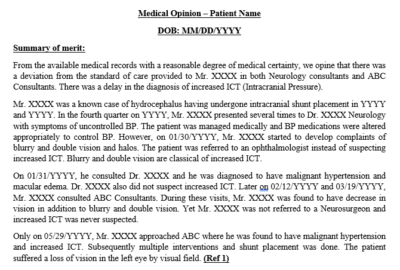Expert Medical Opinion
Medical malpractice cases almost always require a medical expert or a team of medical experts to prove liability. It is often difficult to get an unbiased medical opinion within the practice region due to peer pressure among the practicing medical experts in that region.
At 7 Horses MRR, we retain Indian doctors from the various specialities, who do not have personal relation or professional affiliation with the defendants.
Our doctors perform dispassionate review of the medical records and provide unbiased expert opinion that would be difficult to refute. Our doctors’ opinion is based on the prevailing standard treatment protocol that is followed in the United States health care system.
Medical opinion carries the critical appraisal of the treatment followed in the subject in question versus the right /approved medical protocol.
We Deliver:
- Medical Opinion – Word/PDF
- Free Reference
- Free missing records identification
- We objectively review medical records without any bias considering sides of both plaintiff and defendant.
- We plan our review based on focus required and see where there would be areas of possible medical negligence/malpractice.
- We provide a robust medical opinion based on established research and medical researches.
- We also briefly discuss on the merits and demerits of a trial when it comes to a case and talk about possible weakness (points that a defendant is likely to argue) in proceeding with a trial.
- Lastly, we provide immediate support to our clients and address queries from our clients without any delay.
What is a medical opinion in medical malpractice?
The four D’s of medical malpractice are “duty, dereliction (negligence or deviation from the standard of care), damages, and direct cause”. Each of these four elements must be proved to have been present, based on a preponderance of the evidence, for malpractice to be found.
The principles of clinical medicine and any error in clinical decision play a central role in deciding whether dereliction and direct cause for damages were or were not applicable in a particular case. Our MD’s use data from various cases involving similar care to see if the care rendered is appropriate and comparable to acceptable standards of contemporary treatment.
Brief explanation of a sample opinion:
From the available medical records, it is with a degree of reasonable medical certainty; I opine that there was a deviation from the standard of care provided to Mr. X in screening and diagnosing liver cancer. There was a delay in the diagnosis of liver cancer by Dr. Y
Mr. X had been regularly visiting Dr. Y for gastrointestinal related complaints. He presented with a chief complaint of hepatitis C. He has chronic hepatitis C. He was evaluated for hepatitis C treatment in 1990 but opted for not taking treatment. He was a former IVDA (Intravenous Drug Abuse) occasionally used narcotics. He was started on antivirals in 2017 and was regularly followed up every 4 weeks.
On 04/06/2018, Mr. X presented to Dr. Y with a chief complaint of ascites. The patient has increasing abdominal girth. The patient reported abdominal surgery on November (surgery details are not available for my review), since then progressive and girth increase. An ultrasound was performed on 04/26/2018 and it showed heterogeneous coarsened and nodular liver noted compatible with cirrhosis. With continued clinical concern for hepatocellular carcinoma, further evaluation with more sensitive pre and post contrast abdominal MRI may be helpful as clinically indicated.
I note that Dr. Y never ordered abdominal MRI to look for liver lesions. The recommended screening interval in the Western world is 6 months. Some guidelines have recommended screening is performed every 3 months specifically for “very high-risk” patients, for example, cirrhotic HBV with high viral replication although the evidence on which this was based is scarce. There is a large patient variability in incidence and volume doubling time of HCC and theoretically a 6-month period may be too long for some patients to have their HCC detected at an early stage.
In this case Dr. Y neither ordered regular screening ultrasound nor pre and post contrast MRI abdomen which was suggested in the ultrasound one on 04/26/2018.
Mr. X continued to follow-up with Dr. Y for ascites, hepatitis C and cirrhosis through 2018 and 2019. In 2019, the patient started complaining of weight loss, fatigue and increased ascites. Only on 04/29/2019, Dr. Y referred the patient to ZZZ Hospital for evaluation. CT abdomen performed in ZZZ on 04/29/2019 showed cirrhotic liver and liver mass lesions consistent with malignancy. It reflected primary hepatocellular carcinoma, less likely metastatic disease. It also showed upper abdominal adenopathy consistent with metastasis. CT chest showed no metastatic disease. MRI of the abdomen was done during the admission and it showed heterogeneous nodular cirrhotic liver, focal nodular hyperplasia in the dome of the right lobe of the liver measuring 4.7 cm, multiple enhancing nodules suggesting cirrhotic regenerative nodules or dysplastic nodules. The largest nodule measured 1.7 cm. There was 9.4×7.7×5.7cm mass in the inferior right lobe of the liver suspicious for hepatocellular carcinoma. There was metastatic adenopathy in the upper abdomen with masses ranging from 3.5 to 5.2cm.
How did we draft this opinion?
One we received the case, we understood that our primary focus is delayed diagnosis of liver cancer.
We analysed the patient’s medical history and found out that he was at a risk of liver cancer because of hepatitis C and his history of IV drug abuse.
We found one of the ultrasounds showing heterogenecity concerning of liver cancer. Then we went ahead and analysed how often should we screen patient who is at high risk of developing liver cancer. Recent guidelines say screening has to be done every 6 months.
Since Dr. Y did not screen Mr. X every 6 months, Dr. Y missed out liver cancer and hence there was a delay from early diagnosis.

